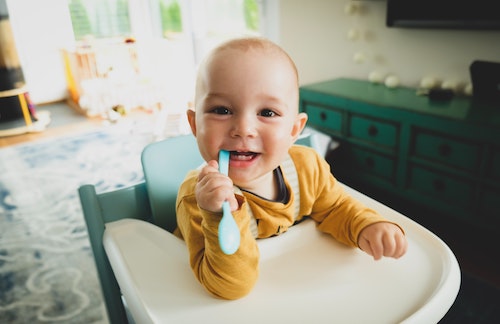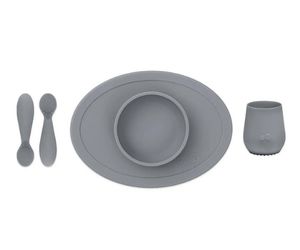If you’re looking for a guide on how to do a combination of baby led weaning and pureed food, then you’re in the right place.
If you just want to do baby led weaning right from the get-go, then this article is also for you.
Here you’ll know the do’s and don’ts of baby led weaning (plus purees), how to prepare and serve both, and other tips that will make baby led weaning (combined with purees!) a success.
Let’s start by knowing what is baby led weaning and what’s the fuss behind it.
I hope you’ll love the products we recommend! Just a quick note: if you click on a product link below and decide to buy it, we may earn a small commission.
Jump to Preparation and Serving | Best First Foods For Babies | Safety Tips | Avoid serving the following food | Frequently Asked Questions
List of Contents
What Is Baby Led Weaning?
Baby led weaning, according to Gill Rapley (health visitor and Ph.D.) is an approach to introducing solid food that is based on the infant’s developmental readiness to ingest foods other than breast milk or formula.
In short, it’s introducing age-appropriate solid food to your kids and letting them choose and control their food intake.
Why Do Baby Led Weaning
Baby-led weaning primarily is done because milk (whether formula or breastmilk), is not enough to sustain your kid at around 6 months of age. They need to get their nutrients from other food, which can come in the form of pureed food or baby-led weaning.
Another reason is the tremendous benefit baby led weaning or BLW offers.
What Are The Benefits of Baby Led Weaning
- Develops fine motor skills (picking, grabbing, etc.)
- Improves hand-eye coordination (bringing the food from their plate into their mouth)
- Improves your baby’s oral-motor skills such as chewing, swallowing, crunching, and tongue movement. Oral motor skills are important for speech articulation and facial expression.
- Encourages healthy eating habits
- Learns to explore food names, textures, smells, tastes, colors, etc.
- Exposes kids to varieties of food
- Makes everyday meal preparation easier
Children who are spoon-fed might not be able to tell you they’re already full. Parents or caregivers might overfeed them, which can result in kids becoming overweight.
Baby led weaning allows kids to learn how to self-regulate – eating according to their hunger levels, and learning to stop when they feel full.
BLW also lets your kids explore and learn from their food – texture, smell, taste, color. It also encourages children to become familiar with a greater variety of food, making them less likely to become picky eaters.
Plus, once you’re way past that certain initial change stage, BLW makes meal preparation easier.
Your baby can eat the same food that you prepare for the rest of the family and there would be no need to mash, blend, freeze, and defrost pureed food for them or separate some BLW food for them.
When To Start Baby Led Weaning
What age should I start baby led weaning?
There’s a whole debate on what age is appropriate for baby led weaning but the American Academy of Pediatrics and the World Health Organization recommends introducing solid food at 6 months of age.
What are the signs of readiness for baby led weaning?
- Sitting up without any support
- Can hold their head up and steady
- Shows interest in solid food
- Absence of tongue-thrust reflex – doesn’t spit out or pushes food with their tongue all the time.
Tips For Starting Baby Led Weaning
1. Manage expectations and don’t give in to pressures.
First, you have to learn how to manage your expectations about baby-led weaning.
Expect mess. And when I say mess, I mean monumental, epic MESS.
My kid at one point decided to rub and “lotion and shampoo” herself with food. I don’t how she managed to do it quickly but I just looked away for a second and the next thing you know, food was all over her.
Literally. It wasn’t always like that, but expect that kind of a monstrous mess.
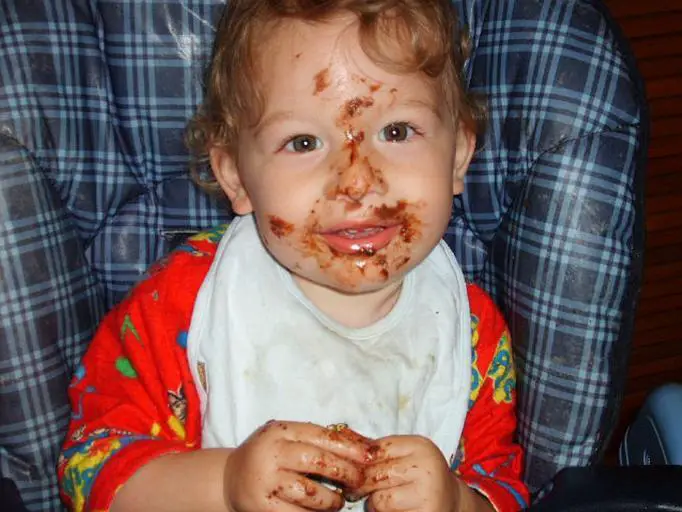
Cleaning was a headache the first few weeks for me but I eventually got used to it.
So learn how to manage your expectations first about the potential mess from BLW. Especially if you want to follow and stick to its philosophy.
Related Article: How to Clean a Messy House In One Day (In Under 6 Hours)
Another thing to manage is your feelings about baby led weaning. Don’t put pressure on yourself or your baby to do baby-led weaning the right way immediately.
There will be days where you think you have it all figured out. Your baby seems happy with their food, they’re eating well and there’s less mess than expected.
Then there will be days where they won’t touch the food, they’ll be mostly throwing it around and you’ll doubt if BLW was even a good idea.
Both are normal, there will be progress and setbacks. But eventually, if your baby is growing normally and is developmentally ready, they’ll be able to get to the rhythm of BLW.
The pressure usually comes with comparing our babies with other kids or loved ones or friends telling you to do BLW already. This is not a competition and don’t let anyone force you to do something, just because they think it’s best for you and your baby.
What you think and what you feel, is best for your kid. Don’t underestimate your instinct, especially when it concerns your baby.
Don’t compare yourself and your baby to them. We all walk at our own pace, we all live our own lives and we all are different.
2. Second, continue giving breastmilk or formula milk.
Remember, your baby still gets the majority of their nutrition from milk until they’re 1 year old.
3. Third, it’s okay if you mix it up.
You can do a full BLW or a mixed one – baby led weaning with purees. There’s no judgment here, do what’s comfortable and best for your family.
I did a combo of both because I was so scared of my baby choking if I do BLW immediately.
It’s also not practical to do baby led weaning all the time, as some daycare centers won’t be on board with it.
Or maybe your caregiver won’t be comfortable with doing baby-led weaning at all.
In such cases, it’s better to just do a combination of baby led weaning and spoon-feed pureed foods.
How To Start Baby Led Weaning (Combined with Puree)
Essential Tools for Feeding Solid Food To Your Baby
It doesn’t matter if you do full BLW, pureed or a combination of both, you’d need these basic tools to feed your baby:
Expect your baby to experiment with not only their food but also their bowls or plates. They will definitely try to remove or throw the bowl or plate.
So having one with a good suction underneath is a necessity, to minimize mess.
Other moms had this idea of using weighted bowls, to limit flipping and tossing.

I’ve never tried it but it kinda make sense to just get one. Because your kid will eventually figure out how to slip their suction bowls. And they will be doing that a dozen times over.
But I digress.
I’d advise you to buy at least 3 bowls or plates, so you don’t need to wash one after every meal.
Just wash everything (along with the other utensils and dishes) at the end of the day.
Get something long-lasting and that’s safe for babies to chew on.
I’d also advise getting 3 sets of it, one for every meal.
You don’t need fancy or pricey bibs but there are certain bibs out there that help contain the mess. Like the GRABEASE bib below:

Yup, they have those types of bibs!
Just chuck it along with your child in the washing machine. kidding, lol.
Whatever your preference, I’ll just recommend buying 3 of those for every meal. Or you can just buy one and clean it up afterward.
Check out some baby led weaning feeding set below:
Lovely Minime Baby Feeding Set
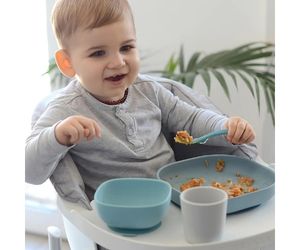
NutriChefKitchen Baby Bamboo Dinnerware Set
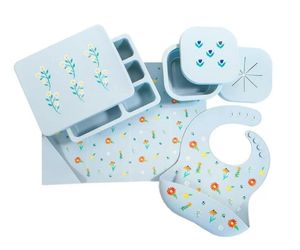
- High chair
I just bought the Ikea chair which we used until our kid doesn’t want to sit on it anymore.
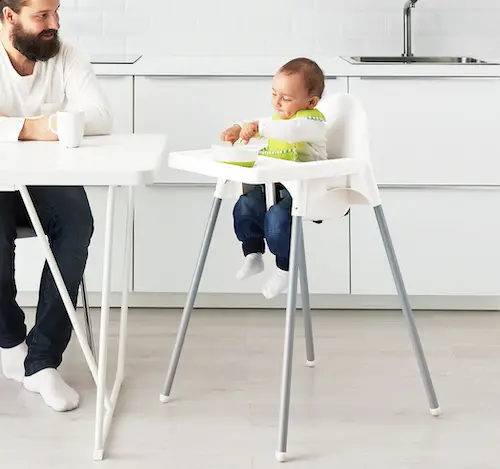
Related Article: Does a High Chair Need a Footrest? (Benefits, Types, Hacks, and Tips)
Something sturdy yet comfortable for your kid will be enough.
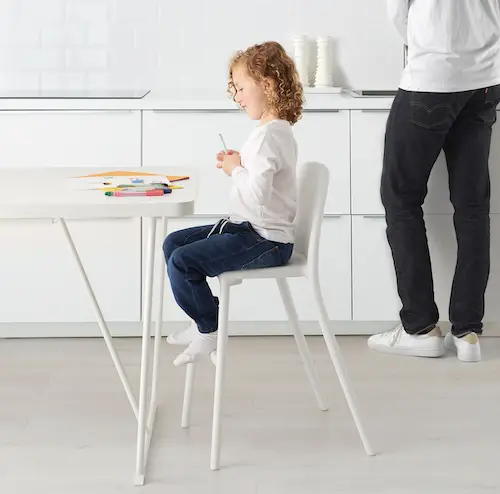
Those chairs that they can use for preschool or older age, would be more value for money.
Get something that’s easy to clean and can be pushed under a standard dining table.
By the way, if you’re considering a Stokke chair, I made a super detailed comparision review here of the Tripp Trapp vs Steps vs Clikk. You might want to check that out.
Related: Advice For First Time Parents: Don’t Buy Any Newborn Essentials Just Yet
Pureed Baby Food: Preparation and Serving
Skip this part if you intend to go full BLW. Jump to Baby Led Weaning: Preparation and Serving | Best First Foods For Babies | Baby Led Weaning Safety Tips | Avoid serving the following food | Frequently Asked Questions on Baby Led Weaning
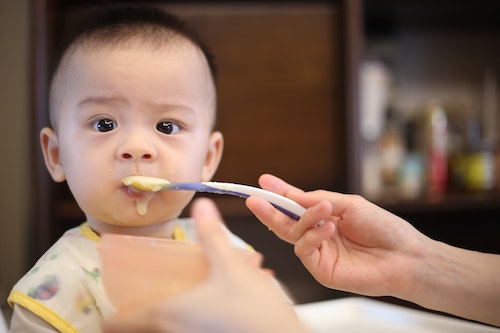
What equipment do I need for pureed baby food?
Preparing pureed food is a lot more work compared to doing baby led weaning but it’s not that complicated.
You don’t need a lot of fancy items or expensive products to prepare and store pureed food.
Keep things simple by just having the following tools:
- Hand blender
Someone told us to buy hand blenders instead of those big bulky ones and it’s probably one of the best advice I’ve ever received.
It made making puree recipes one after another way more convenient as it hand blenders are easier to clean and handle.
I remember making 3-4 baby purees in one sitting!
Remember, you’re just introducing food to your little ones so you don’t need bulks of pureed food. Plus you’re eventually going to do baby led weaning, hence my advice to just get a hand blender.
- Food masher
You can just use a fork but mashing food is quicker when you have a dedicated food masher.
You can use a food masher when serving food that’s a little bit lumpy and less blended. You can choose to manually mash it yourself or just use a blender.
- Food storage containers
Get something airtight and safe for both freezing and heating in the microwave. Something that you can stack on top of each other is also convenient, so you can still have some more space for your other freezer foods.
What initially worked for me for the first 2 months was this oxo tot container.
If you need to cook more food, you can use the next item.
- Breastmilk storage bags/ Ziploc freezer bags
I had a lot of these since I only breastfed for 2 months.
Storing food, thawing, and even clean up is a breeze with breastmilk storage bags. I used this brand of breastmilk storage bags and it worked splendidly.
You can also use Ziploc freezer bags if you don’t have enough breastmilk storage bags.
How to prepare pureed baby food?
You can choose to steam or slow cook your baby’s food until it’s soft enough to be mashed or blended.
Use the hand blender to make it into a smooth or puree texture. You can add in water or milk for a runnier texture.
How to store pureed baby food?
You can use dedicated food storage containers or as mentioned, breastmilk storage bags or Ziploc freezer bags.
Just remember to label the bags with the name of the meal and the date you cooked them so you’ll know which is which.
Frozen baby puree can last from 1 to 3 months in the freezer but I don’t let it stay there for too long. I usually just freeze 1 to 2 weeks’ worth of purees then I make a new batch again.
Take note that this is a combination with baby led weaning so you don’t need massive amounts of pureed food for storage. Make sure to properly close the containers or seal the bags for storage.
How to thaw frozen pureed baby food?
You can thaw frozen food in 3 ways: in the refrigerator, using cold water, or microwaving them.

If you want to thaw in the refrigerator, you have to place it from the fridge to the refrigerator and leave it there overnight or at best, 24 hours, for it to soften and to safely thaw.
This is a longer but safer process so prepare in advance.
If you want to thaw in water, just submerge the packed food (preferably in a breastmilk or Ziploc bag) in water and replace the water every 30 minutes.
Don’t let it stay out for too long to avoid bacteria build-up.
You can also choose to microwave your baby’s food if you’re in a hurry. But make sure to check for hot spots which can burn your baby’s mouth. To avoid that, mix everything thoroughly and taste how warm it is with a spoon first, before giving it to your baby.
How do I feed my baby pureed food?
Just spoon-feed your baby and see how they react to the food. Take a small amount of food using the spoon and let your kid taste it. See how they react to it.
If you’re planning to do a combination of BLW and pureed food, keep spoon-feeding your kid. Then after a few weeks or so, if you’re comfortable enough, give them a spoon preloaded with food and let them feed themselves.
I spoon-fed my baby for at least a month then I let her explore the food by either using a spoon or using her fingers. It will be messy and they will not be on target all the time with the spoon, but remember, they are in the exploration and learning stage.
And you’re also in the lookout for possible allergies they might have with the food you’re serving.
Baby Led Weaning: Preparation and Serving
What equipment do I need for baby led weaning food?
None! Because you can just serve your baby the same food you’re serving the rest of your family.
How to prepare baby led weaning food?
Some families are okay with serving their babies the same food that everyone is having.
But if you’re not comfortable with all the salt, sugar, or spices that are in everyone’s meal, then before adding those ingredients, get some portion first for your baby.
You can also prepare your baby’s food separately.
Cut up the food into finger-like shapes that are easy for your baby to grab and hold.
You can steam or slow cook it. Make sure that your baby’s meal is soft enough to squish between your fingers.
How to store baby led weaning food?
Since most of the baby-led weaning food are meals that you’re serving the rest of your family, you can also store it the usual way – by using dedicated, safe and BPA-free food containers.
Just follow the safety precautions as always in storing and thawing food.
I make sure to only take out enough food from the freezer that I know my baby can eat and I don’t serve her anything that has been in the fridge for 2 days.
How to thaw frozen baby led weaning food?
The same thing that you thaw regular food – you can choose to thaw it in the refrigerator, using cold water or microwaving them.
Just follow the usual safety protocols for thawing and always check for hot spots (which can burn your baby’s mouth) when microwaving.
How do I feed my baby led weaning food?
Serve it on a plate, bowl, or on the table of their high chair. Let them reach for it.
Give them 2-3 pcs of that single-ingredient food initially than see how they react to it.
You can prod them along on how to touch and eat it by reaching and grabbing a piece yourself, to encourage them.
Hopefully, they’d want more but if they’re starting to fuss, don’t force them to eat it. Remember to make mealtimes enjoyable so they’ll think of eating food in their high chair in a positive way.
Mealtime Schedule
Offer solid food 3x a day, just like how you’d have your meals. It doesn’t matter if your kid eats a lot or none of it, just offer them food during mealtimes.
This reinforces the mealtime concept. It also makes things simpler for you, instead of following some complicated milk+solid food feeding schedule.
Remember to only give one single ingredient food every 3 to 4 days to watch out for allergies.
So for eg., they’ll have their milk then that will be supplemented with say, carrots, 3x a day for 3 to 4 days straight.
Then move on to the next food if you don’t see any allergic reaction. If your baby has gone through all the first stage food, then it’s time to mix things up with other single-ingredient foods or give them new ones.
Daily Food Intake
The recommended solid food intake for every meal is 3-4 oz or 3-4 tablespoons for 6 months old.
Take note though this is only a guideline as most babies won’t be eating that much solid food initially.
Let them get used to the idea of eating solid food first and gradually increase their food intake until they’re getting enough for their age.
Again, don’t force your babies into eating or taking more food.
Best First Foods For Babies
Infant cereals used to be the top-recommended solid food for babies because of the added iron but the AAP now says it’s okay to feed your kids any “single-ingredient” food.
Again, give it to your kid for at least 3-4 days straight, to look out for allergies.
Here are the best first foods for babies (recommended for 6 to 8 months old), which you can give as pureed, mashed, or just serve as a baby-led weaning food:
- Carrots
- Sweet potato
- Banana
- Avocado
- Apples
- Pears
- Peaches
- Green beans
- Butternut squash
- Mango
- Parsnips
- Pumpkin
- Zucchini
- Tofu
- Baby cereal, such as oatmeal, rice, barley
The following foods below can also be introduced to your kids as no evidence suggests waiting to give these kinds of food will prevent food allergies, according to the AAP.
- Chicken/ Turkey
- Eggs
- Fish
- Cheese
But of course, if you’d prefer to wait (like I did!), that’s also totally fine. I remember waiting until my kid’s 8th month, to give her eggs and chicken.
I did give her baby cereal to supplement her need for iron-rich foods.
Jump to Tips For Starting Baby Led Weaning | Essential Tools for Feeding Solid Food To Your Baby | Pureed Baby Food: Preparation and Serving | Baby Led Weaning: Preparation and Serving | Best First Foods For Babies | Baby Led Weaning Safety Tips | Avoid serving the following food | Frequently Asked Questions on Baby Led Weaning
Baby Led Weaning Safety Tips
Before starting on your baby led weaning journey, take note of these tips to keep your baby safe.
- Eat together
This not only encourages healthy eating habits and family bonding, but it also allows you to watch your baby like a hawk, should they start, god forbid, choking.
Watch a video below on what to do if your baby is choking here.
- Avoid distractions
Watching TV and playing games on your phone are potentially dangerous distractions that can deter you from helping out your baby immediately when they’re choking.
It can also distract your baby from eating their food properly, which can lead to gagging or worse, choking.
Don’t also let your baby eat while playing or crawling or reclining. Don’t also give them any food in the stroller or the car. Let them stay in their baby chair throughout a meal.
- Offer soft, finger-shaped foods
Foods that are shaped into a “finger-like” piece are safer to eat and easier for your little ones to grab and hold on to.
Also, make sure that the food is soft enough that you can easily squish it between your fingers, lowering the risk of choking. Think of the firmness of a banana, you can hold it but you can also easily mash and squish it.
- Know the difference between gagging vs choking
Gagging is a common reflex. It’s often a sign that your baby is getting adept at moving food inside their mouth.
There’s a lot of noise involved in gagging – coughing, sputtering, watery eyes, red face – as your baby tries to push the food away using their tongue.
If you see and hear them doing all of this, don’t panic just yet.
It’s best to stay calm and let your baby work this out on their own, so they can learn how to cope with solid food without getting scared. A child who’s choking, on the other hand, might be quiet or even silent, since food is stuck in their throat or windpipe.
Signs of a baby choking include trouble breathing, they might be gasping or wheezing, they can’t seem to cry, their lungs are pulling inward, their faces are turning blue or they might be grabbing their throat.
If this happens, start first-aid immediately and/or call for help.
- Food allergy
Knowing how to look out for food allergies is also necessary when doing BLW.
Food allergies can quickly occur within minutes, an hour, or two, or maybe longer.
Common symptoms to look out for are skin and tongue swelling, hives, throat tightness, sneezing, vomiting, stomach pains, and diarrhea. If symptoms are more severe, such as trouble breathing or losing consciousness, call help immediately.
- Learn first aid
God forbid this ever happen to my child (knock on wood) but it sadly happens and at least one child dies from choking on food every five days in the US.
Learning to recognize the signs of choking and how to respond to it is therefore a must when you decide to do BLW.
- Educate caregivers
It’s necessary to teach caregivers the essentials of baby led weaning.
But if they are not on board with it, it’s best not to push it.
It’s better to be safe than sorry and if that means doing a mix of BLW and pureed food, then that’s ultimately better than other people not knowing how to do BLW the proper way and not knowing how to give first-aid to a choking kid.
Related: 4 Major Essential Baby Care Tips For New Moms
Avoid serving the following food
- Honey
Never give babies younger than 1-year-old honey, as it can cause botulism, a serious illness that comes with breathing troubles, constipation, and muscle weakness.
- Cow’s milk
Difficult to digest for kids under 1 year old.
- Choking hazards
Whole grapes, whole nuts, whole cherry tomatoes, popcorn, raisins, raw vegetables, sticky food, hotdog, and even those with tougher skin like apples or those that can form crumbs in their mouth, basically anything that can be dislodged on their throat is a dangerous choking hazard.
I’m not saying don’t serve apples, just lose the skin and cut it into thin strips and probably make it a bit softer by steaming it, so it will be safe for babies to eat.
- Certain types of fish
Those that have higher amounts of mercury, like swordfish or marlin may affect your baby’s nervous system
- Sugary snacks and drinks
Your baby does not need sugar, so don’t give them sweet snacks and even fruit juices and fruit drinks.
- Salty food
Crackers, crips, and food with stock cubes or gravy are a no-no for babies, as it’s bad for their kidneys. Don’t also put salt in your baby’s food, they don’t need it for now.
Frequently Asked Questions on Baby Led Weaning
Does the AAP recommend baby led weaning?
Yes, provided that your kid is age and developmentally ready and that food served is cut up and prepared appropriately.
Can you combine baby led weaning and purees?
Yes, of course! Whichever makes you comfortable. As long as your baby’s main source of food is their milk, doing BLW or purees or a combo of both is fine.
Remember, solid food is just supplementary food up until their first year and this is not a race to see which baby can feed themselves first so just do what you feel is safe and comfortable for your baby.
Will my baby get enough nutrients from baby led weaning?
Yes, provided that they are still breastfeeding or drinking their formula milk.
Milk is still their primary source of nutrients for up to 12 months. Solid food is only supplementary food.
Also, the initial stages of introducing solid food to your babies are more for exploring and learning so don’t worry too much about their solid food intake.
How do I know if my baby is getting enough food to eat?
If they’re acting and growing normally, meaning they are:
– consistently alert and playful
– peeing and pooping regularly
– continuously learning new skills, and exploring their environment Then they’re doing fine, they’re getting enough food and nutrients.
Remember, the initial stages of eating solid food are all about exploration for your baby and learning how to eat solid food. We cannot expect them to immediately learn how to eat enough food to sustain their needs.
As long as they’re getting their milk regularly and as long as the milk is their primary source of nutrition, at least for the first year, they’ll do just fine.
Do babies need teeth for baby led weaning?
No, they don’t need teeth. They mash the food with their gums. That’s why the solid food needs to be soft enough for them, for safe eating.
Besides, not all babies get their teeth, until they’re 10 months or so.
But of course, every baby is different. So don’t worry, your baby doesn’t need any teeth to eat their food.
How do I know if my baby has had enough food?
If they start turning away their head and just refuse to eat more food, then they’re probably full or they just don’t want to eat anymore. And that’s okay.
It’s all about exploration for them and learning how to self-regulate so it’s perfectly fine if they don’t finish the food you’ve served them or even ate only a little bit of it.
When can I introduce potentially allergenic foods to my baby?
You can introduce them as soon as your baby starts eating solid food. Waiting to give them such food will not prevent food allergies, as evidence suggests, according to the AAP.
But, if you have a family history of food allergy, it’s best to consult with a pediatrician first.
Daycare/ caregiver doesn’t want to do BLW, what should I do?
I’d highly advise not to push it. If they’re not comfortable because of safety reasons (choking hazards) then it’s better not to force them on the baby led weaning wagon.
As long as your baby is safe and eating the right and proper way, it’s okay to mix up baby led weaning with spoon-feeding.
Fed and being safe is also best.
Can my baby eat the same food that I serve my family?
Yes, you can, if one, you’re comfortable with giving your baby food that might be salty, spicy, etc, and two, it’s safe for them to eat, shape-wise and allergic-wise.
Baby Led Weaning with Purees: Takeaway
There’s no wrong or right way to do baby led weaning or introduce solid food to your baby. There’s the safe and unsafe way but I digress.
Just remember first to manage your expectations – especially when it concerns messes and your baby’s food intake.
Next is follow food safety guidelines and learn first aid. And don’t forget to make mealtimes light and fun for your baby.
If you want some idea on how to plan meals for your family and your baby, read my 6 super simple meal planning tips here and get your meal planning printables right on that page!

